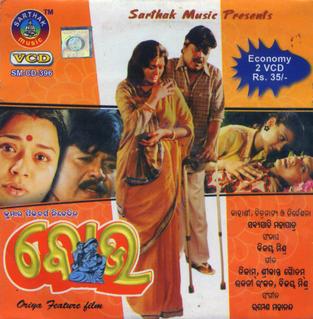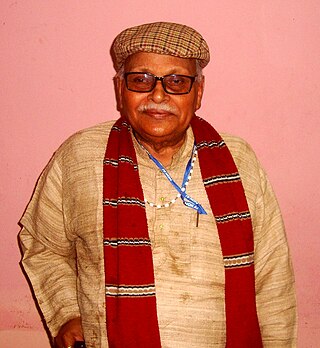Contents
This is a list of Odia language authors.
This is a list of Odia language authors.

Odia is an Indo-Aryan classical spoken in the Indian state of Odisha. It is the official language in Odisha, where native speakers make up 82% of the population, and it is also spoken in parts of West Bengal, Jharkhand, Andhra Pradesh and Chhattisgarh. Odia is one of the many official languages of India; it is the official language of Odisha and the second official language of Jharkhand.

Ravenshaw University, formerly known as Ravenshaw College, is a co-educational state university situated in Cuttack, Odisha on the eastern coast of India. Founded as Ravenshaw College in 1868, the institution became a university in 2006. The university has nine schools, thirty three academic departments and a student enrolment of nearly 8,000. It is one of the oldest educational institutes in the country and its history is synonymous with the history of modern Odisha.
Odia literature is literature written in the Odia language, mostly from the Indian state of Odisha. The modern Odia language is mostly formed from Tadbhava words with significant Sanskrit (Tatsama) influences, along with loanwords from Desaja, English, Hindustani (Hindi/Urdu), Persian, and Arabic. Its earliest written texts date from around 1000 CE. The earliest Odia newspaper was Utkala Deepika, first published on August 4, 1866.
Odisha is one of the 28 states of India, located on the eastern coast. It is surrounded by the states of West Bengal to the northeast, Jharkhand to the north, Chhattisgarh to the west and northwest, and Andhra Pradesh to the south and southwest. Odia is the official and most widely spoken language, spoken by 33.2 million according to the 2001 Census. The modern state of Odisha was established on 1 April 1936, as a province in British India, and consisted predominantly of Odia-speaking regions. April 1 is celebrated as Odisha Day.

The Odia cinema, colloquially known as Ollywood, is the Odia language Indian film industry, based in Bhubaneshwar and Cuttack in Odisha, India. The name Ollywood is a portmanteau of the words Odia and Hollywood.

Odissi music is a genre of classical music in India, originated from the eastern state of Odisha. The traditional ritual music for the service of Lord Jagannatha, Odissi music has a history spanning over two thousand years, authentic sangita-shastras or treatises, unique Ragas & Talas and a distinctive style of rendition.

Bou is a 1998 Indian Odia-language drama film. It was directed, produced and written by Sabyasachi Mohapatra. Usasi Misra, Jyoti Misra and Akshaya Bastia debuted in the film.

Mohapatra Nilamani Sahoo, surname also spelt Sahu, was an Indian Odia language short story writer. He received several literary awards over his career, including the 1979 Odisha Sahitya Academy Award for Akasha Patala, and the 1983 Sarala Award and the 1984 Sahitya Akademi Award in Odia, for Abhisapta Gandharba. Sahoo died on 25 June 2016 after multiple organ failures.

Gopalakrusna Pattanayaka was an Odia poet & composer of Odissi music. His Odissi songs in various traditional ragas and talas are widely sung across the state, as well as other allied traditional artforms of Odisha, such as pala. The 20th-century Odissi musician, vocalist & binākara Apanna Panigrahi, also from the poet's hometown, was well-known for his renditions of Gopalakrusna's lyrics. Some of the most iconic Odissi songs, such as Syamaku Juhara Tara Premaku Juhara Ma, Jala Ani Jai Kali Kalindasutaku, Sangini Re Rasarangini Re, Kadamba Bane Bansi Bajila Re, Uthilu Ede Begi Kahinkire, Ki Nadare Prana Sangini, Manasija Mana Mohana are creations of Gopalakrusna. Many of his songs are popular abhinaya items in Odissi dance.
Dhanasri is a rāga belonging to the tradition of Odissi music. Falling under the meḷa of the same name, the raga uses komala gandhara and komala nisada swaras and is traditionally associated with the karuṇa rasa. The raga is mentioned in treatises such as the Gita Prakasa and Sangita Narayana.
Gujjari is a rāga belonging to the tradition of Odissi music. Falling under the meḷa Karnāta, the raga uses komala gandhara, komala dhaibata and komala nisada swaras and is traditionally associated with the karuṇa rasa. The raga is mentioned in treatises such as the Gita Prakasa and Sangita Narayana. Among its angaragas, Mangala Gujjari is most prominent and has been used by Jayadeva in his Gita Govinda, alongside Gujjari itself.
Ramakeri is a rāga belonging to the tradition of Odissi music. Falling under the meḷa Barādi, the raga uses komala rusabha, komala dhaibata and tibra madhyama swaras and is traditionally associated with the karuṇa rasa. The raga is mentioned in treatises such as the Gita Prakasa and Sangita Narayana. This raga has been used by the 12th-century Odia composer Jayadeva in his Gita Govinda.
Baradi is a rāga belonging to the tradition of Odissi music. Falling under the meḷa Barādi, the raga uses komala rusabha, komala dhaibata and tibra madhyama swaras and is traditionally associated with the karuṇa rasa. The raga is mentioned in treatises such as the Gita Prakasa and Sangita Narayana. This raga has been used by the 12th-century Odia composer Jayadeva in his Gita Govinda along with its angaraga Desa Barādi.
Sokabaradi is a rāga belonging to the tradition of Odissi music. Falling under the meḷa of the same name, the raga uses komala rusabha, komala dhaibata, komala nisada and tibra madhyama swaras and is traditionally associated with the karuṇa rasa. The raga is mentioned in treatises such as the Gita Prakasa and Sangita Narayana.
Mangala Gujjari is a rāga belonging to the tradition of Odissi music. Falling under the meḷa Karnāta, the raga uses komala rusabha, komala gandhara, komala dhaibata and komala nisada swaras along with their suddha counterparts and is traditionally associated with the karuṇa rasa. The raga is mentioned in treatises such as the Gita Prakasa and Sangita Narayana. This raga is traditionally believed to have been created by Jayadeva in his Gita Govinda.
Abhiri is a rāga belonging to the tradition of Odissi music. Falling under the meḷa Karnāta, the raga uses komala gandhara, komala dhaibata and komala nisada swaras and is traditionally associated with the karuṇa rasa. The raga is mentioned in treatises such as the Gita Prakasa and Sangita Narayana.
Debakiri is a rāga belonging to the tradition of Odissi music. Falling under the meḷa Dhanasri, the raga uses komala gandhara and komala nisada swaras and is traditionally associated with the karuṇa and bhakti rasas. The raga is mentioned in treatises such as the Gita Prakasa and Sangita Narayana.